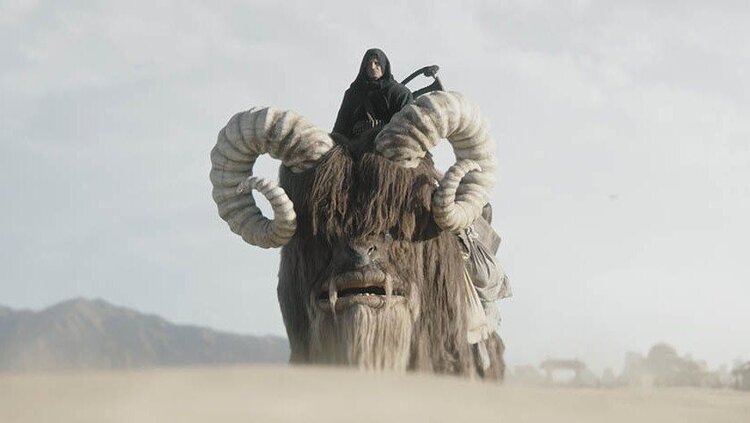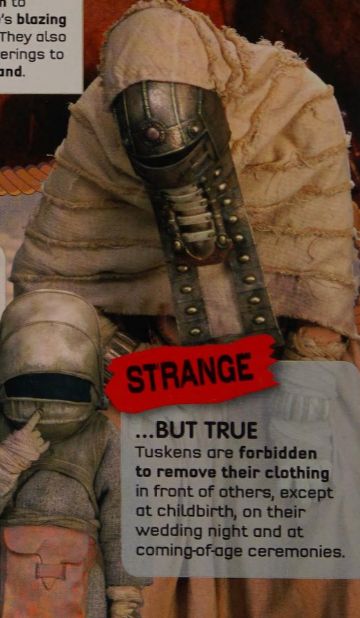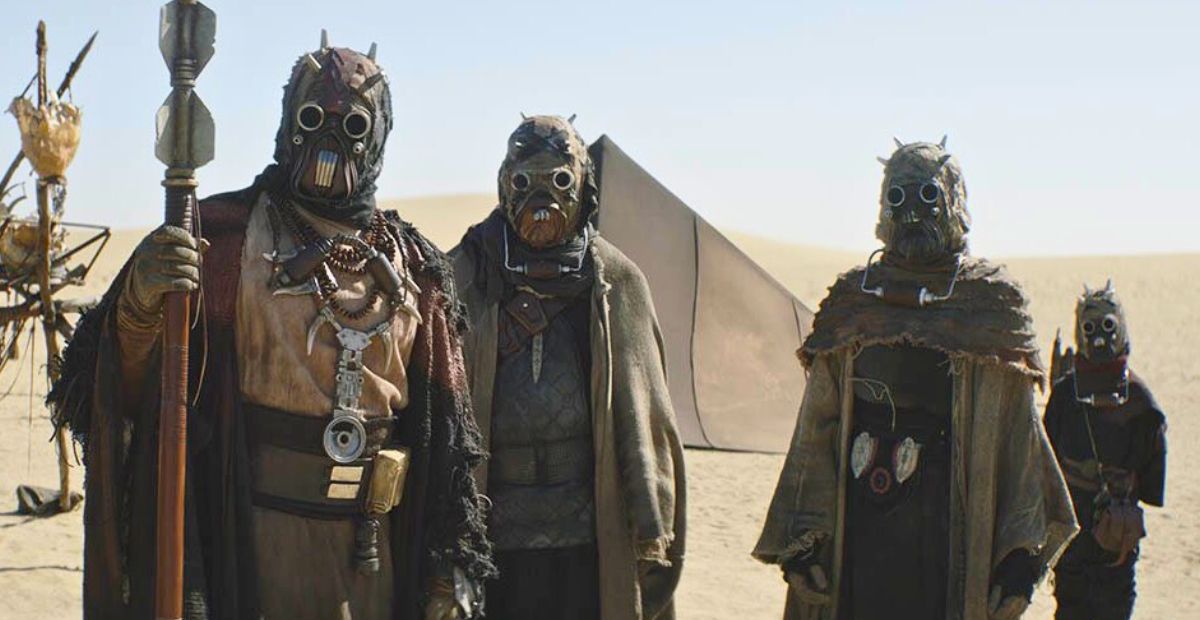When most fans think of the Tusken Raiders, the first image that pops into mind is probably the sand-masked nomads attacking Luke in A New Hope or clashing with Anakin in Attack of the Clones. They’ve always been portrayed as brutal desert warriors, but there’s actually way more to them than just being scary figures with gaffi sticks.
So today, let’s pull back the mask (not literally — they’d hate that) and go through some fun facts about the Tuskens. Some of these you might already know, others might surprise you, but all of them show that there’s more depth to these sand dwellers than most people realize.
1. A Tusken Raider Actor Won an Oscar
One of the coolest behind-the-scenes facts about the Tuskens is tied to The Mandalorian Season 1, Episode 5. The Tusken Raider who communicates in sign language wasn’t just a random extra — it was played by Troy Kotsur, the deaf actor who later made history by winning the Oscar for Best Supporting Actor in CODA.
But Kotsur’s contribution went way beyond just playing a Tusken on screen. He actually helped create the Tusken Sign Language that you see in The Mandalorian and The Book of Boba Fett. Instead of simply borrowing from American Sign Language, Kotsur researched the desert environment of Tatooine and the culture of the “sand people,” as Luke once called them. He wanted the language to feel organic — something that came from the Tuskens’ world, not ours.
For Kotsur, it was a dream come true. He’s shared in interviews that A New Hope was the film that inspired him as a kid — even though he couldn’t hear the dialogue, the visuals were so powerful that he went back to see it nearly 30 times. Decades later, to not only appear in Star Wars but to give the Tuskens their own language was, as he put it, the perfect opportunity.
2. The Tusken Raiders Are Hostile to Protect Their Resources
You ever wonder why the Tusken Raiders always seem so aggressive? I mean, they’re shooting podracers, raiding farms, ambushing anyone who gets too close… at first glance, it just looks like they enjoy causing chaos. But here’s the thing — they’re not doing it just for fun.
According to the official Star Wars Databank, “Tuskens are territorial, xenophobic, and extremely dangerous to settlers and moisture farmers. Their need to protect dwindling resources makes them hostile to outsiders.” And that right there is the key — it’s about survival.
Life on Tatooine is brutal. Water’s rare, food’s harder to find, and even land itself is precious. From the Tusken perspective, outsiders digging wells or setting up farms aren’t just annoying neighbors — they’re a direct threat. Another Databank entry puts it bluntly: “Tatooine’s Tusken Raiders hated outlanders, attacking all those who trespassed on their territories and raiding outlanders’ towns and farms.”
So really, their hostility isn’t random — it’s protective. They’re defending what little they have left in a wasteland where one wrong move can mean starvation. And if you’ve seen The Mandalorian, you know how true this is: when outsiders respect their ways, the Tuskens can be reasoned with. But when people ignore their boundaries? That’s when the gaffi sticks and long rifles come out.
3. Tusken Raiders Share a Sacred Bond With Banthas

If you picture a Tusken Raider in your head, odds are you’re also picturing a Bantha right next to them. And that’s not by accident — the two are inseparable. For the Tuskens, a bantha isn’t just a mount to ride across the desert, it’s a lifelong companion.
According to the Star Wars Databank, banthas “serve as mounts for Tusken Raiders, and the two share a close bond.” That bond is almost sacred. When a Tusken comes of age, they’re paired with a bantha, and from that point forward, their lives are tied together. If one dies, the other often grieves so deeply that legends say the bantha will even wander into the desert and perish soon after its rider.
Banthas are woven into almost every part of Tusken life — migrations, rituals, even family structures. They carry supplies, provide milk and fur, and stand at the center of ceremonies. Without banthas, Tusken culture simply wouldn’t exist the way it does.
4. To Become Adults, Tuskens Must Defeat a Krayt Dragon
When you think about Tatooine’s most terrifying creature, the Krayt Dragon probably comes to mind. Now imagine being a Tusken teenager and being told that to truly become an adult, you’ve got to face one. Sounds insane, right? But that’s part of their tradition.
In The Mandalorian season 2, we see a whole tribe of Tuskens work alongside Din Djarin to take down a massive Krayt Dragon, treating the battle almost like a sacred ritual. That gives us a glimpse of just how important these creatures are in Tusken culture.
Legends stories and fan accounts take it even further, saying that young Tuskens around the age of fifteen are expected to hunt a smaller “Canyon Krayt” as a rite of passage. Some versions even mention them retrieving a pearl from the beast as proof of their victory. While that part isn’t firmly established in canon, it makes sense when you think about how dangerous life on Tatooine really is.
For the Tuskens, killing or even surviving a fight with a Krayt Dragon isn’t just about bragging rights. It’s the ultimate test of courage, marking the moment when someone is no longer a child but a full warrior of the tribe.
5. Tuskens Only Remove Their Robes for Life’s Biggest Moments
When you picture a Tusken Raider, you instantly see those layers of robes and wraps, right? It’s their look — head to toe covered, trudging across the Tatooine desert. But here’s the wild part: those robes aren’t just for protection from the sun and sand. They’re sacred, and Tuskens almost never take them off.
In fact, the only times they do are for the biggest moments in life. As kids, Tuskens all wear the same kind of clothing. But once they hit adulthood, they trade those robes for outfits that show their role and gender. And later, the only other times the robes come off are during mating and childbirth. That’s it. Imagine wearing the same kind of sacred outfit your whole life, only taking it off at the most important turning points — that’s how much it matters to them.
Even the details mean something. Men usually wear wrappings that are tight and layered so they can move easily in combat, while women wear looser shrouds and sometimes jeweled masks. To us, it might just look like desert gear. To them, it’s identity, tradition, and survival all rolled into one.
According to Star Wars: Absolutely Everything You Need to Know “Tuskens are forbidden to remove their clothing in front of others, except at childbirth, on their wedding night and at coming-of-age ceremonies.”


